Are you considering a PMO setup at your company? This article explains how to set up a PMO / project management office in four simple steps.
In the following sections, you will learn about:
- PMO setup – Just think of it as a normal project
- PMO setup – Step 1: Current status – analysis & general concept
- PMO setup – Step 2: Preparation and specification
- PMO setup – Step 3: Implementation of the plans
- PMO setup – Step 4: Make the PMO an integral part of normal operations
- Change management – A key success factor right from the start
- Conclusion – PMO setup
After discussing the recommended four steps, the article concludes by describing which PMO success factors will help you obtain buy-in from the affected stakeholders.
But let us get started now.
PMO Setup – Just Think of It As a Normal Project
Deciding to create a project management office means launching a new project. The methods used are the same as for any other project:
- You start by analyzing the current situation.
- Next, you develop a specific plan.
- Then, you implement this plan and integrate it into the normal operations.
Throughout the phases, your smart change management strategy is used to help bring the stakeholders on board. This promotes the project’s acceptance and helps ensure its success.
Please note, however: You will need to adapt your strategy for PMO setup to the current situation and your company’s level of experience in project management. This is a challenge for every organization, as you will soon discover, because there is no one-size-fits-all approach to either the PMO or the process itself.
So, you may find it helpful to use a generic, incremental approach to PMO setup, as it will serve as a point of orientation. The following graphic provides an example.
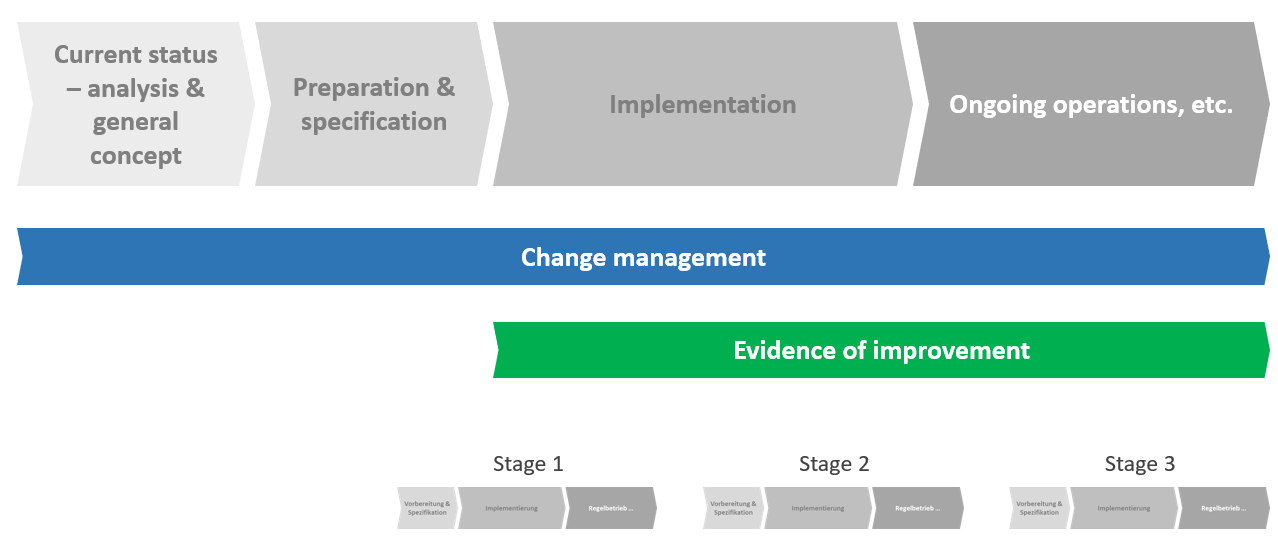
In this generic framework, PMO setup involves these four steps:
- Current status – analysis & general concept
- Preparation and specification
- PMO implementation
- PMO normal operations
In addition to these four steps, it helps to have a good change management program for interacting with the people affected. This is because most people, at least initially, are skeptical about any proposed changes. So, be prepared to face resistance to your project again and again. You will need to convince these people / stakeholders.
Reading tip: Why Have a Project Management Office (PMO)?
Visible support from top management is essential, so make sure you have it. It often helps convince the other stakeholders.
One more tip: Right from the start, begin collecting proof that establishing a PMO is having a positive effect on the projects. This evidence will help you counter any possible criticism.
Now let us take a look at the individual steps involved.
Special Download: How to setup a PMO in 4 simple steps (PDF file)
Please fill in the form.
* Required Fields | Data Protection
Step 1 for PMO Setup: Current Status – Analysis & General Concept

The first step in PMO setup is to analyze the current situation. Take a look at the PM methods, processes, and tools used so far. Scrutinize the most important current projects for weaknesses.
In our experience, it is important to check for these key items in this phase. If you determine that any of these are (still) missing, you can make introducing these the first objective of your newly established PMO.
1. Project-Worthiness Analysis – What Do You Consider a “Project”?
Start by defining what exactly should be handled as a formal project. Only things clearly defined as a project fall under the jurisdiction of the PMO. Ask yourself: what activities are better handled as part of the normal operations and are therefore under the jurisdiction of the individual departments?
A project-worthiness analysis tailored to your company will help you make this decision.
| Number of areas involved | 1 area | Up to 3 areas | Over 3 areas | Up to 3 areas |
| Size of entire project team | 2 – 5 people | Over 6 people | Over 12 people | Over 6 people |
| Resource requirements | 10 – 30 man-days | 30 – 100 man-days | Over 100 man-days | 30 – 100 man-days |
| Capital expenditure | Under 10.000 € | 10.000 – 50.000 € | Over 50.000 € | 10.000 – 50.000 € |
| Duration | 1 – 3 months | 4 – 10 months | Over 10 months | 4 – 10 months |
| Inherent complexity | Low | Medium | High | High |
| Novelty for project team | Low | Medium | High | Low |
| Quality risk | Low | Medium | High | Medium |
| External impact | Low | Medium | High | Low |
Our tip: Download our free Project-worthiness analysis template (MS Excel). You can easily adapt the template to your needs.
2. Prioritized Project Lists – Which Projects Are Currently Being Pursued?
One of the key objectives is to obtain a complete list of all the projects. It must be up to date, detailed, and ideally also prioritized. Without a complete list, you will have no idea what people in the company are really working on.
Let us be honest: are you sure that your list is complete?
Our experience has shown that few companies actually have a complete list at this stage. Even if it takes a few weeks to prepare the list, it will be well worth the effort and a great help to everyone involved.
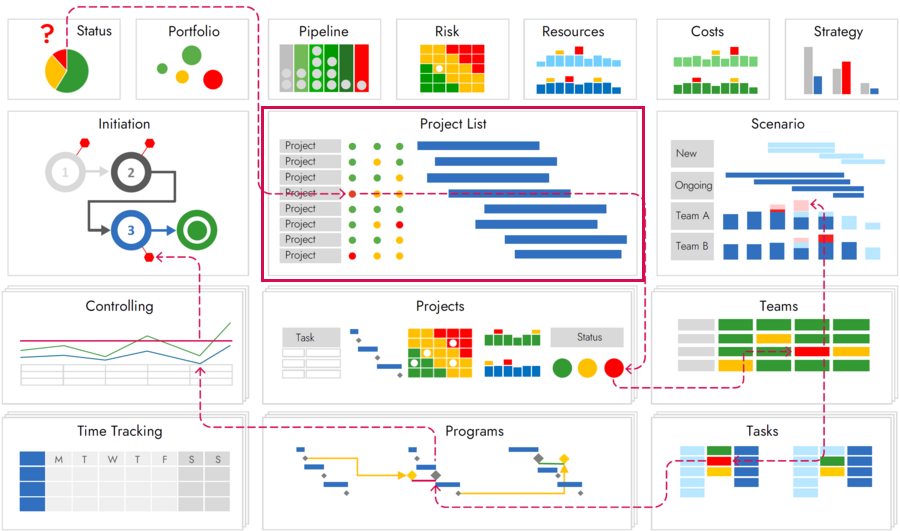
The graphic above shows the TPG PPM Paradise. Individual projects are automatically added to the project list. This list provides the up-to-date and accurate information needed for the portfolio reports on which management bases its decisions.
Download now: Free eBook (PDF) on “The PPM Paradise”
Here is what an optimal customizable solution for project, portfolio and resource management (PPM) should be capable of – tips and important arguments for your decision-makers. > Download eBook (PDF) “The PPM Paradise”
Users of agile methods, please note: PMO setup is essential if you have multiple projects running concurrently, even in an agile environment. Having a complete, accurate list of all the projects is essential for every decision-maker.
Things to keep in mind for the project list and / or tool used to prepare the list:
- It must accept any number of user-defined fields.
- It must have a function for sorting, filtering, and grouping the entries by field.
- It must provide different views based on user permissions.
- Ideally, it offers workflows for adding new projects.
- It must allow you to configure the links to detailed information.
- The list must be pre-filled with key historical data.
- This historical data must be sufficient to detect future trends.
- This history also serves as evidence of the PMO’s contributions.
Our tip: Make sure that every single project is included on your project list. Avoid having any stealth projects that secretly steal your resources. Your primary responsibility as project management officer is to ensure that the list is always complete and up to date!
3. Control Environment – Can We Make Valid Decisions?
Another thing to consider is the control environment. It should include key elements such as:
- Project order (project objective, budget, time frame, etc. with signature)
- Project status report (detailed with traffic light status indicators)
- Final project report (project’s overall result)
- Lessons Learned (What went well and what did not?)
Our tip: In this first phase of establishing a PMO implementation, you need to ask many questions: How helpful have previous project status reports been? What was their intended purpose for each of the stakeholders? What things could be optimized?
4. Processes – Are They Effective and Efficient?
Remember to take a close look at your company’s existing project management processes. It is vital that you check the effectiveness and efficiency of the tools and methods being used.
One important factor is your company’s organizational structure (line / matrix). Take a close look at the training opportunities and career paths available to those involved in project management.
Your findings will help you determine the level of project management maturity in the company. Make sure that you document this.
Not everyone in the company will be enthusiastic about the creation of a PMO, so you will need all the good feedback about positive changes that you can get.
Our tip: Start your work as project management officer by documenting the company’s level of project management maturity. This can help you achieve some quick wins and later clearly demonstrate the improvements and added value.
5. Stakeholder Analysis – What Does Each Person Want?
Knowing what everyone wants will help you define the PMO’s goals. The stakeholder analysis is a helpful tool in determining: What are the PMO’s interest groups and what do they hope to gain from the PMO?
Possible stakeholders range from managers and executives as well as decision-makers and team leaders / Scrum Masters, to project managers / Product Owners, the controllers and, finally, the employees.
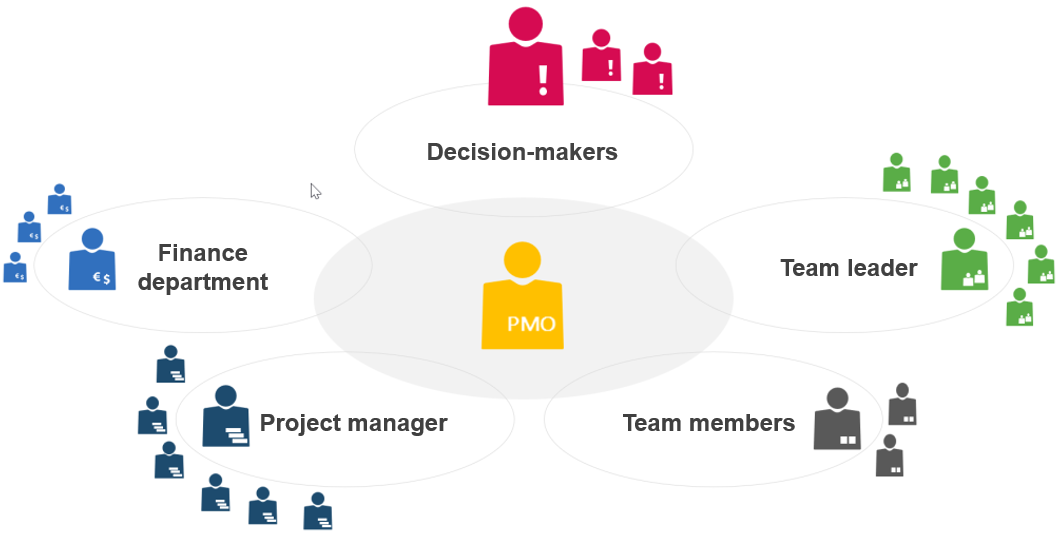
The PMO is a service provider whose success depends on the satisfaction of its “customers”, namely, the stakeholders in the project environment. Each of these stakeholders has their own expectations of the PMO.
Our tip: Start by doing a good stakeholder analysis to ensure that you have a clear understanding of every stakeholder’s expectations of the PMO. This will let you set the right goals and lead to greater acceptance of your work.
6. Gap Analysis – What Does the Target / Actual Comparison Show?
After you have analyzed the current situation and defined the expectations, it is time to do the gap analysis. This analysis depicts the gap between the current status and the desired status of project management in the company.
The information can then be used to create a prioritized list of recommended actions. The list should also include measures that can be quickly and easily implemented, so-called “quick wins”.
Here are a few ideas for quick wins when you set up a PMO:
- A clear project-worthiness analysis
- A signed project order for each project
- A prioritized list of projects
- A good stakeholder analysis
- An up-to-date project status report
You can sustainably close some of the gaps defined in your gap analysis by, for example, defining a PM maturity model that can be introduced in stages.
Our tip: Complete the quick wins identified on your list as early as possible. These early successes will help boost the PMO’s acceptance.
Step 2 for PMO Setup: Preparation and Specification

The next phase involves developing the concept. Here you define the PMO’s work, its position in the hierarchy, and its competencies. The PMO should have a clear understanding of its mandate and the services it is expected to provide.
The scope of services is often broad, and the stakeholder expectations are high. Possible PMO services can be seen in the following list.
- If training and coaching are the focus of the newly established PMO, then it will organize professional development activities for the project managers and project teams.
- The PMO’s project services activities will consist mainly of providing support. For example, it can host workshops or temporarily assume the role of project controller.
- If methods and processes constitute the PMO’s core competencies, then it will focus primarily on these and make suitable IT tools available to those needing them.
- Multi-project management monitors the progress of various projects and defines the control measures. In this case, the PMO gathers project information and prepares this for the decision-making committees.
- The Strategic Project Management Office (sPMO) is responsible for setting up and managing the projects. It chooses the projects and prioritizes them. The PMO also conducts cost-benefit analyses and defines the overall conditions for the project management.
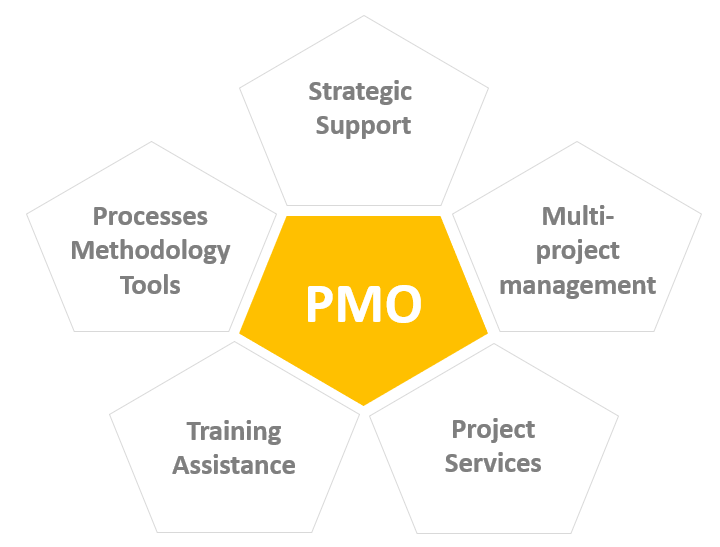
Once you have established a PMO, it is a good idea to start by focusing on only one or two of these responsibilities. You want to avoid over-burdening the organization. Make sure that everyone is aware of the PMO’s mission.
A newly established PMO is still a “strange newcomer” in their midst. It will take a while for everyone to accept it as an integral part of the organization.
Stakeholders often tend to overburden the PMO with activities.
It is important to remember that the PMO will not be able to please all the people all of the time. It has one key responsibility ‒ the one derived from the stakeholder analysis ‒ and this should always be its primary focus.
Our tip: Ensure that the PMO’s mission is one that is both practical and tailored to your organization. Get stakeholder input and agreement on this. Doing so ensures that the PMO’s scope of responsibilities is realistic.
Other key requirements:
- Communication: Make sure that everyone knows that a PMO exists and what its responsibilities are. This ensures that everyone’s expectations are clear.
- Internal marketing: Publicize the PMO’s services so that people actually request and use these services. To be truly accepted as part of the company, the PMO has to offer clear benefits.
- Staffing: The PMO staff must have the necessary qualifications and motivation ‒ this is vital. The employees must be service-oriented and have the required interpersonal skills, but also be able to say No when necessary.
If you have already been using change management to facilitate the transition from one phase to another, its role will grow in importance in the next stage of your PMO implementation.
Our tip: Ensure that the new PMO’s scope of responsibilities is clearly communicated to all the stakeholders. One idea is to set up a PMO homepage on your company’s intranet with information about the PMO team, its services, and project management workflow processes.
Step 3 for PMO Setup: Implement the Plans

If it has not happened already, this is the stage in PMO setup, where the PMO staff receive their final training and are helped to prepare for their duties.
You will need their expertise to implement the PM processes and methods defined in the concept phase step by step. This generally includes agile methodology as well as the traditional together with hybrid approaches that combine these two methods.
Our tip: Select a senior employee to lead the PMO. Choose someone with good organizational skills and many years of project management experience. Make sure this person also has the truly necessary interpersonal skills.
Project Launch – Traditional, Agile, or Hybrid?
One of the PMO’s responsibilities can be to decide whether a project should be handled using agile, traditional, or hybrid methodology. It can define criteria for the degree of uncertainty in the requirements as well as which solution should be used based on this uncertainty. A Stacey Matrix can be helpful here.
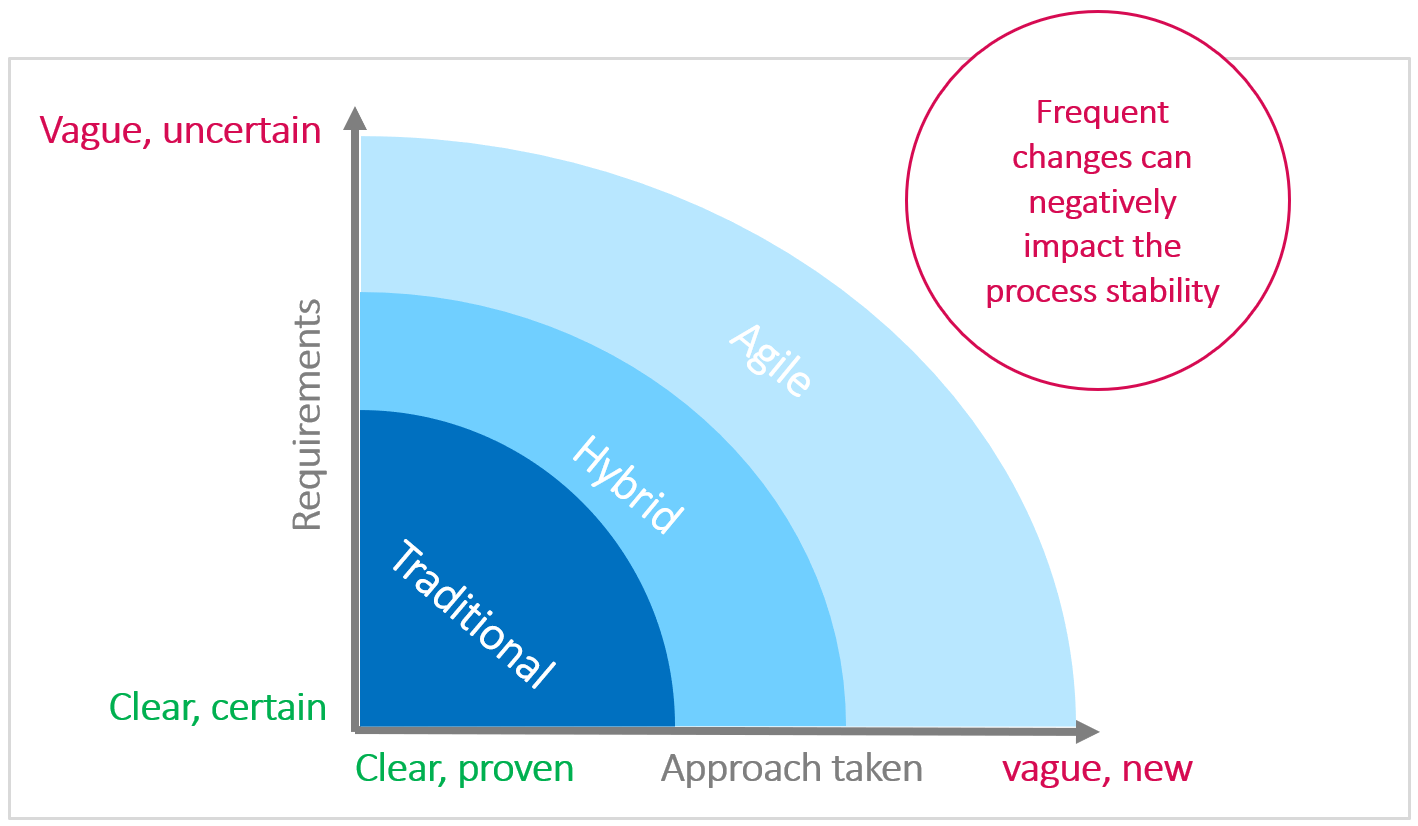
Please note: Do not expect your project managers to switch between agile and traditional too often. Our experience has shown that this can jeopardize satisfaction and process stability.
Methods – Which Are Vital?
Traditional methods that the PMO must use in any case are:
- Project order (as a refence)
- Status report
- Final report with Lessons Learned
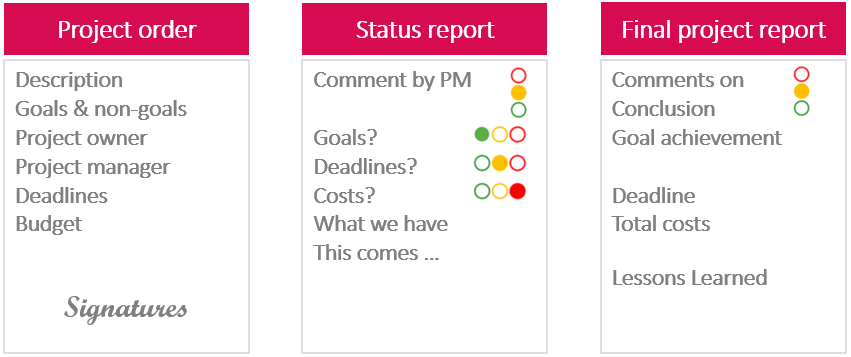
Special Download: 10 Vital PMO Success Factors (PDF file)
Please fill in the form.
* Required Fields | Data Protection
The following graphic shows several other methods common to traditional project environments that the PMO may need to consider. The PMO also provides a suitable IT infrastructure, offers training, and assists users in applying the methods and tools.
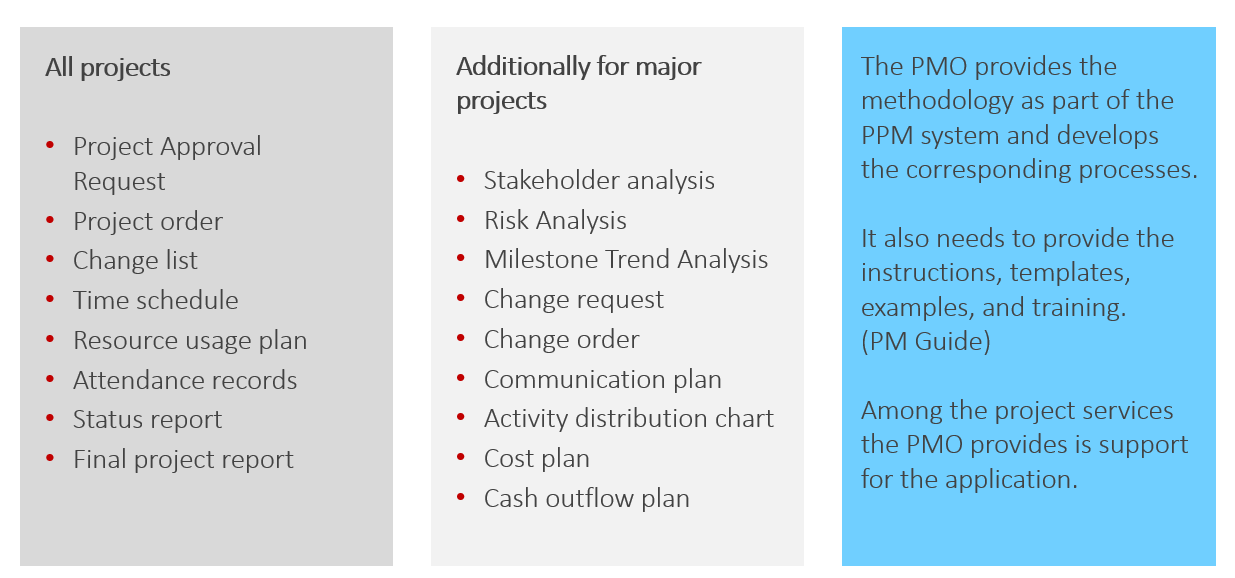
Processes – At What Intervals Should These Occur?
One of the PMO’s key responsibilities can be summarized as:
The PMO ensures that everyone knows what is important and right.
In traditional as well as agile project environments, the PMO is responsible for ensuring that the required processes are carried out at the right intervals. The right information needs to be made available with a regularity that ensures it is both up to date and reliable enough for good decisions.
The following graphic shows how to collect and disseminate information in such a way that this is shared with the organizational levels involved as often as needed.
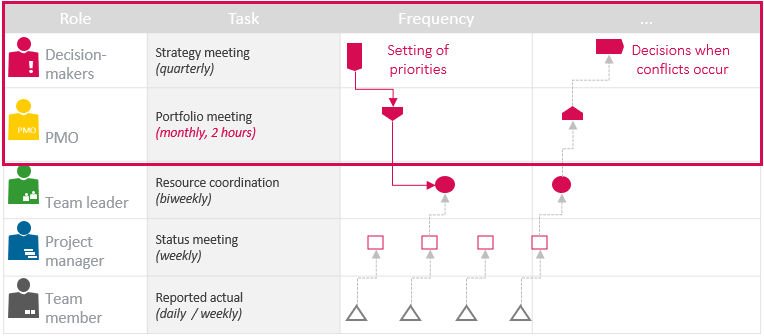
Recommended reading: Comparing Project Management Methods: Agile, Traditional, or Hybrid? – What you should know about how agile differs from traditional and hybrid methods, and how to decide which is best for your needs.
Portfolio Meeting – What Do You Need to Keep in Mind?
The PMO is responsible for ensuring that the portfolio meeting, whose purpose it is to monitor and manage the multi-project environment, achieves its objectives. The key is to have all the necessary information readily available and up to date. Having this information is a prerequisite, as it enables the decision-making committee to make fast, reliable decisions based on the most current data.
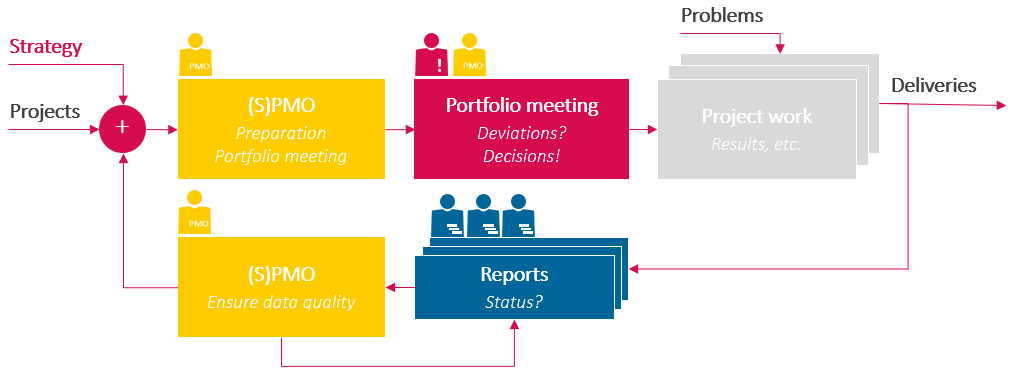
To ensure that the project information presented in the portfolio meeting is up to date, a weekly plan can be used, for example. This enables you to remind the project staff and project managers on time to provide the necessary information in accordance with a periodic deadline.
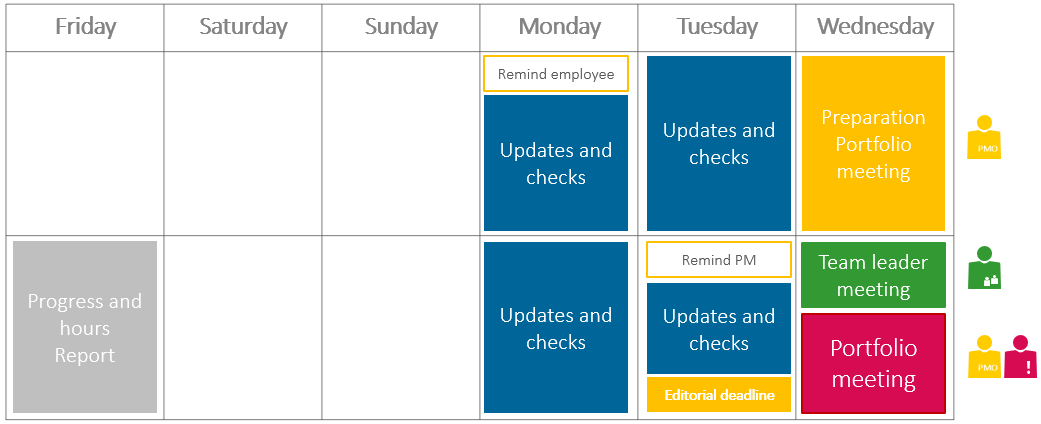
Make sure that everyone submits their input before the editorial deadline, 2-4 hours before the meeting begins. This gives you enough time to be well-prepared and avoids any last-minute changes.
What kinds of topics are discussed in a portfolio meeting? Here are a few typical items:
- Project conclusions (final reports, successes, and lessons learned)
- Information on new projects (project orders)
- Information about key projects (status reports, risk analyses, milestone trend analysis [MTA], etc.)
- Upcoming decisions to be made
- Presentation of the resource situation
- Solutions to resource overload / underutilization
Before the portfolio meeting ends, you should discuss and reach an agreement on how the information about the meeting’s key conclusions will be communicated to the staff. This helps ensure that the employees feel well-informed about the decisions that affect them.
The project portfolio meeting is the place to discuss any project problems, such as those showing a red alert. Having the right tools lets you “drill down” from the project portfolio level into the details of any individual project. The PMO is responsible for providing the tools needed to do this.
TPG PPM Paradise provides this capability:
Special Download: Advantages of MS Project Server / Project Online over MS Project Standard
Please click here to download the PDF and learn why you should prefer the server over the client version.
Resource Management – What Is Everyone Working On?
One of the PMO’s key duties is allocating resources to the various projects.
A prerequisite is, therefore, having a complete overview of each employee’s activities – both project-related and non-project-related.
However, do not make the mistake of being overly detailed in your resource planning. Find the right degree of granularity. For example, you do not want to make your plans so detailed that one person calling in sick throws off all your plans.
Our tip: Aim to make your resource plans as good as necessary for decisions to be made at the portfolio level. More details are unnecessary.
Resource management involves all the levels:
- Decision-makers (which projects are (still) possible, given the resource situation?)
- PMO (prepares the resource utilization overview for that time period so that portfolio decisions can be made)
- Team leaders (schedule the team members and their operational and project-related duties)
- Project managers (work with the team leaders to coordinate the procurement of the resources needed for the projects)
- Team members (report the hours worked, progress, and remaining work to be done)
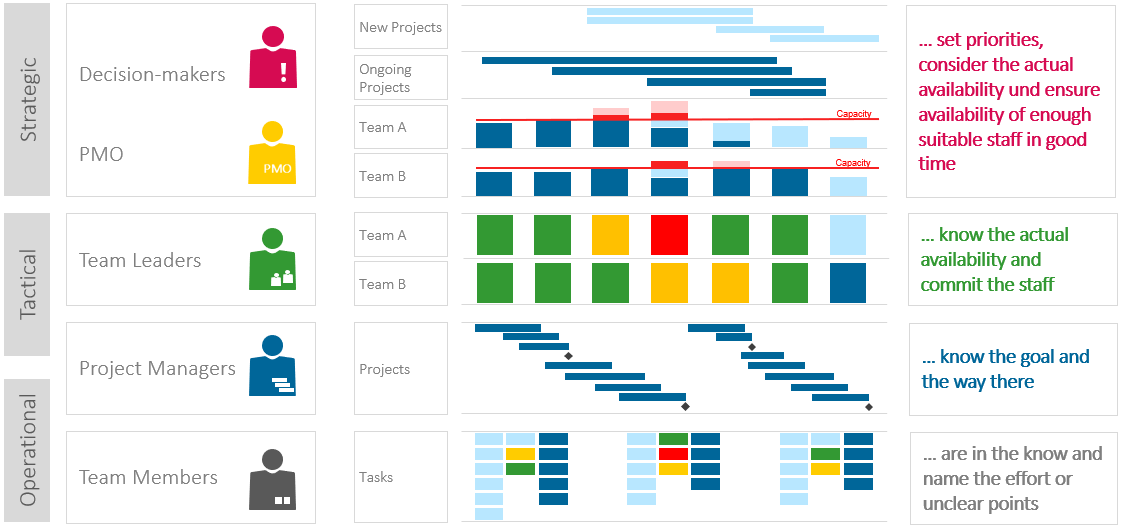
Recommended reading: Project Resource Management – Basics and Areas for Beginners
Knowledge sharing is also a key success factor in minimizing the risk of resource bottlenecks and project delays. Avoid having “gurus” ‒ experts who prefer to work alone and not share their knowledge ‒ as these can become a resource bottleneck. The problem here is that the project can come to a standstill if this person is suddenly unavailable.
As project management officer, it is your responsibility to ensure that this critical knowledge is shared by several people in the team. This helps you avoid any unnecessary downtime in the project. Make sure that your company’s team leaders understand this as well.
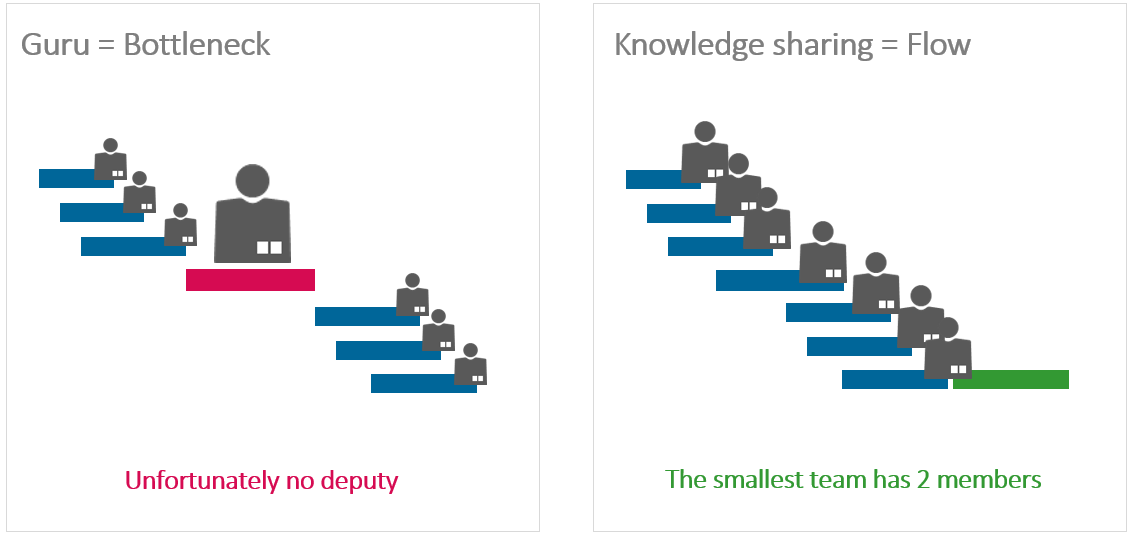
Special Download: Resource Planning Software for the Roles Involved (PDF file)
Please fill in the form.
* Required Fields | Data Protection
Step 4: Make the PMO an Integral Part of Normal Operations
After establishing a PMO, it becomes part of normal operations. If the PMO was implemented by an external consulting firm, it is now time to transfer responsibility to company employees.
In some cases, it may be advantageous for the PMO to retain the consulting firm’s services as needed for specific questions. Depending on what progress has been made in developing the necessary expertise, you may want to consider providing coaching for the company’s project managers and possibly also the project management officers.
In this phase, continue to optimize your processes and methods. Good communication, right from the start, is the key to fostering acceptance of the changes.
Another important point to remember when highlighting the advantages of having a PMO: the company’s corporate culture plays a key role in the PMO’s success. Because ensuring transparency in the project environment is one of the PMO functions, its success will also be measured by this benchmark.
Our tip: When judging your PMO’s long-term success, ask yourself what degree of transparency the company actually wants and whether everyone involved is really trying to be more open about everything.
Change Management – A Key Success Factor Right from the Start
Throughout all the phases ‒ from the analysis of the current situation to the transition to the PMO being part of normal operations ‒ change management is done concurrently to all the other work. As explained above: it is important to demonstrate the benefits of your newly introduced PMO to all the stakeholders as quickly as possible to convince them of its advantages and thereby gain their acceptance.
This is generally achieved in three phases:
Phase 1: If the PMO can show some quick wins, the stakeholders will initially be happy that someone is finally tackling the issues that need to be taken care of. They will then be more willing to accept the PMO.
Phase 2: In this next phase, after the new structures and expertise have been introduced, reality sets in. As everything becomes more transparent, people become more skeptical. They begin wondering what effect the new PMO (and its objectives) will have on them personally and whether any of these effects will be detrimental.
Phase 3: If the implementation is successful, people will eventually recognize the advantages of having the PMO. Their previous skepticism will be transformed into positive collaboration. Now, the PMO can gradually introduce a new project management culture within the company and bring it to life.
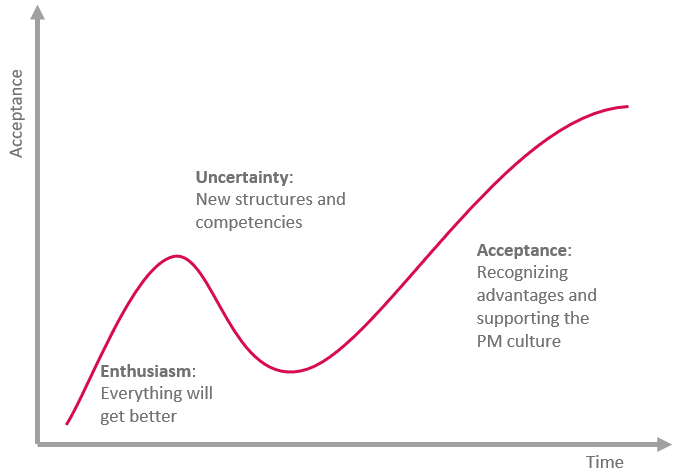
The below infographic is based on a German-language podcast episode on the TPG Podcast. Feel free to share it in your social networks:
Conclusion – PMO Setup and Success Factors
This article has helped you understand that PMO setup is handled as a project. After the project’s launch comes the planning, the implementation, and then the normal operation. You have also learned that there are other factors, beyond simply following the right steps, that can influence the success or failure of your endeavor:
- Carefully planned change management
- Having the support of top management
- A desire for more transparency within the company
Remember that even the best PMO cannot be successful unless the stakeholders recognize the value of this new organizational entity and are willing to actively cooperate with it. Once you have their recognition and willingness to collaborate, you will have the acceptance necessary for the PMO to be successful.
This is the list of 10 key PMO success factors for PMO setup:
- Honest analysis of the PM weaknesses
- Complete stakeholder analysis
- Clear differentiation between project work and general operations
- Determination of baseline expertise so that progress can be measured and documented
- Achievement of quick wins
- Clear definition of PMO duties and expertise
- Manageable scope of responsibilities
- Clear communication of the PMO’s mission
- Use of change management right from the beginning
- Visible support from top management
Our final tips:
If you wish outside help in establishing a project management office (PMO), you will find it here: PMO Consulting.
Get to know the individually adaptable “PPM Paradise” – the optimal environment for your enterprise-wide project, program, portfolio and resource management. Download the eBook now (just click, no form).
And sign up for our bi-weekly blog newsletter to make sure you receive all our updates.
What has been your experience with PMO setup? What words of advice would you give someone trying to set up a PMO? Please leave us a comment.
 Achim Schmidt-Sibeth (Senior Marketing Manager)
Achim Schmidt-Sibeth (Senior Marketing Manager)
After earning his engineering degree in environmental technology, he gained many years of experience in project management through his work at an engineering office, an equipment manufacturer, and a multimedia agency. Achim Schmidt-Sibeth and his team have been responsible for marketing and communication at TPG The Project Group for many years now.
Read more about Achim Schmidt-Sibeth on LinkedIn or XING
 Johann Strasser
Johann Strasser
(Managing Partner at TPG)
The certified engineer has been managing partner at TPG The Project Group since 2001. After many years as a development engineer in the automotive and energy sectors, Johann Strasser spent a decade as an independent trainer and consultant in the field of project management. During his tenure, he also served as project manager for software projects in the construction industry and provided scheduling and cost management support for large-scale construction projects. At TPG, he applies his expertise in product development and consulting services for international clients. His special focus is on PMO, project portfolios, hybrid project management, and resource management. For many years now, he has shared his knowledge through presentations, seminars, articles, and webinars.





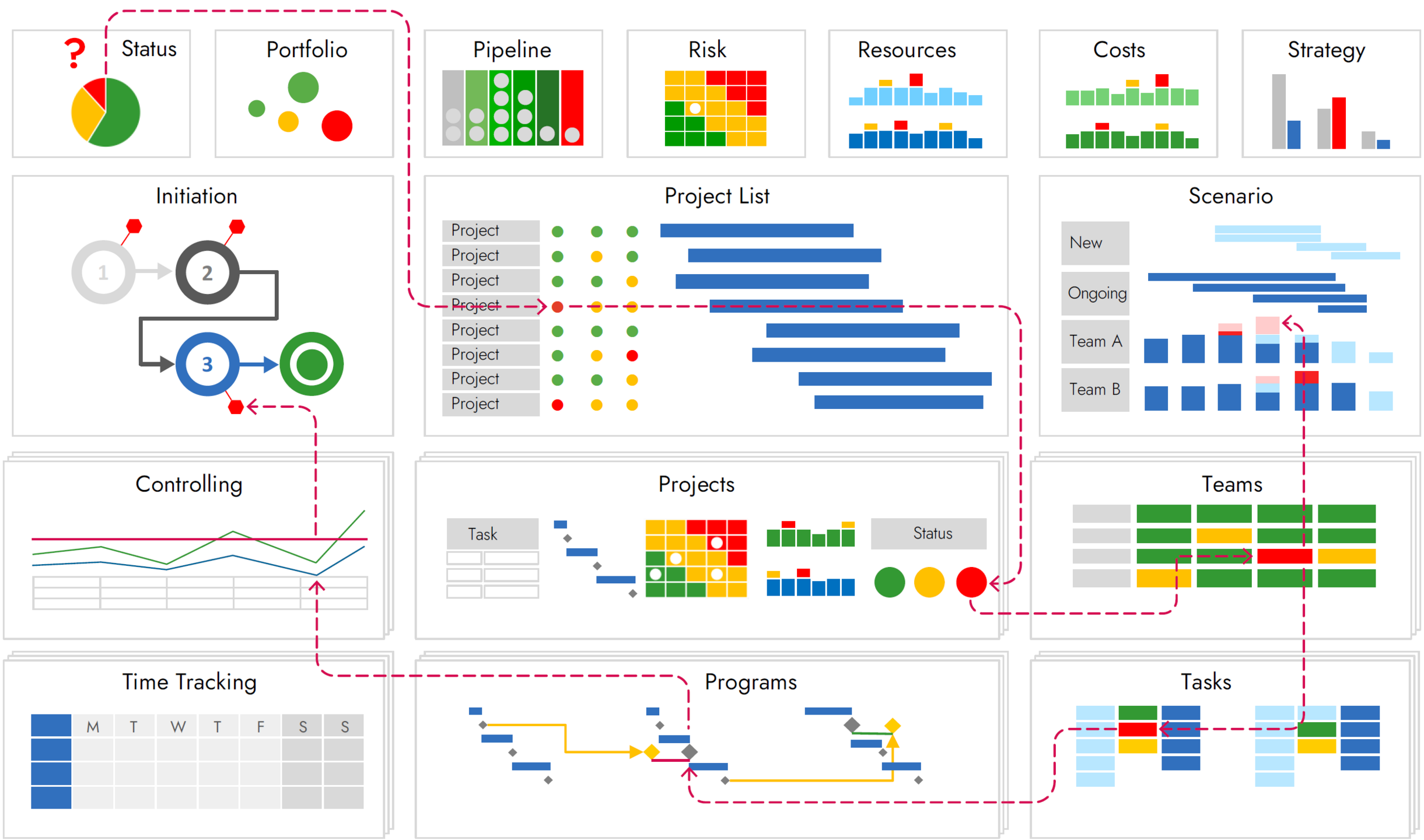
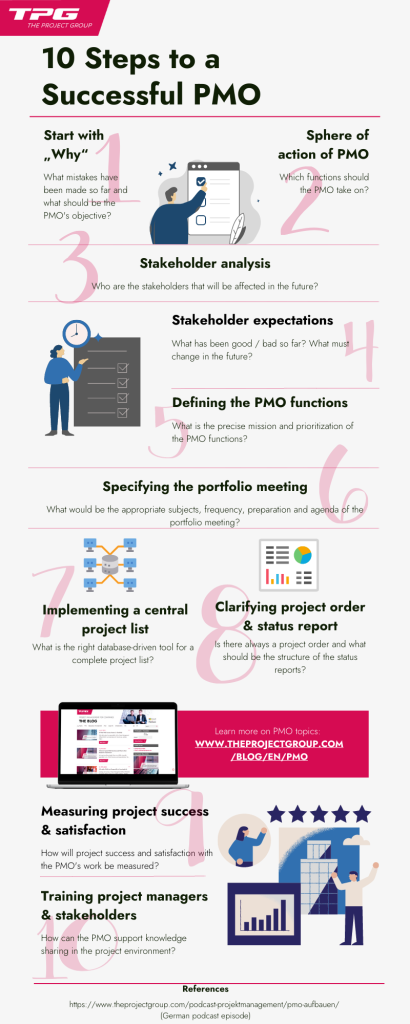
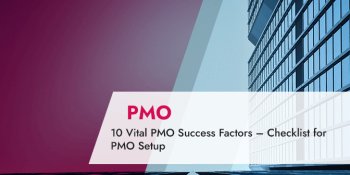
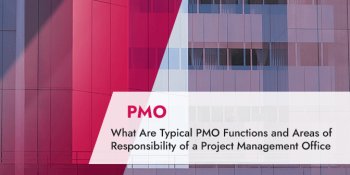

21 Comments
Hi there to every body, it’s my first visit of
this weblog; this webpage consists of amazing and genuinely good stuff for
readers.
Thank you for your comment, dear Mr Balon.
one of the best reads in setting PMO Office
Thank you. We’re happy to hear that.
Fantastic article. I really appreciate this and the visuals included. Well done.
Thanks a lot, Michelle!
Excellent article! Thank you very much for sharing your experience!
Thanks for you feedback, Dan!
This site is a MBA in the shape of website. You need to change the name from:
https://www.theprojectgroup.com to MBA.THEPROJECTGROUP.COM.
Fantastic.
Thank you 🙂
Awesome information – clearly outlined with great visuals. Thank you!
Thank you!
Excellent article. It helps me a lot. Thank so much 🙂
Thank you, glad it was helpful to you.
Excellent content. Surprising that it was so readily available.
Excellent article. It helps me a lot. Thank you so much.
We’re very happy to hear that! Thank you.
Lots of useful information to digest here – thank you. I am in the early stages of gathering together a portfolio view of our organisation’s multiple strategic projects and will be referring to your site frequently I think..!
One small question please, is an English-language version of the Project worthiness analysis template (MS Excel) readily available please? Currently this links to a German-language template.
Thanks again!
Dear Jim,
Thanks a lot for your valuable feedback. It may have taken a while, but the English template is now available in the article (we have also updated the link above).
Hello,
Is “novelty of people involved” the same as “peoples experience with the project” the same in the project worthiness assessment excel?
Thanks!
Uriel Vargas, thanks for pointing out this inconsistency. While “project team’s experience with similar projects” and “novelty for people involved” may refer to the same idea, “Low” and “High” would have needed to be switched in the former case. We have published various images of the project-worthiness analysis on this blog. I have now replaced the old image with the latest one (this one has “novelty” instead of “experience” making correct use of “Low” and “High”, so it should end the confusion). By the way, the link to the Excel template is still there. Just click on the banner below.